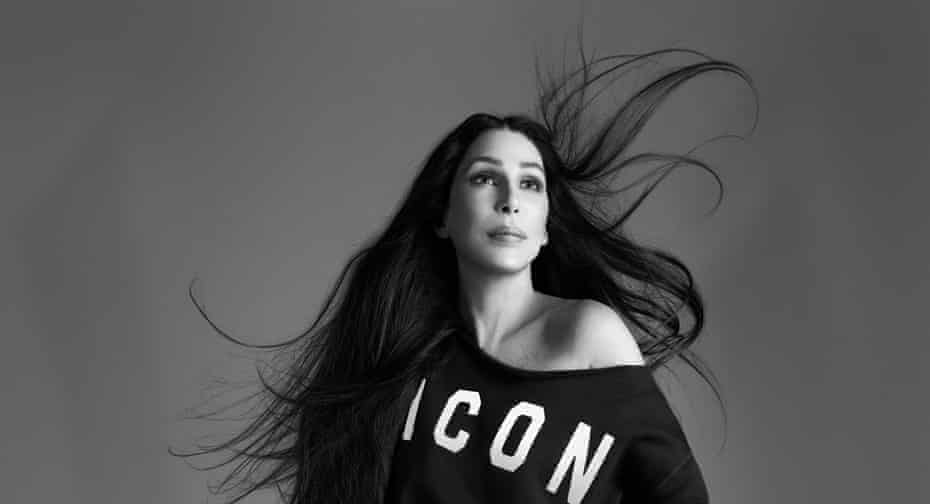
Cher: ‘I love the feeling you have in your body when you sing.’
Her $60m annual Las Vegas residency was off the cards this year, but the singer still has lots to say about animal rights, Trump’s ‘toxic’ politics, cosmetic surgery and the men in her life
by Simon Hattenstone
Mon 14 Dec 2020 06.00 GMT
The Goddess of Pop is in town. And what an entrance she makes. Two-tone black-and-white beret, matching jacket, skinny jeans, black boots, black mask, and an elephant-shaped knuckle-duster. She looks the ultimate in revolutionary chic – Cher Guevara. She is not in London to promote a record (100m sold and counting) or a film (she won the best actress Oscar in 1988 for Moonstruck); she is here to talk about rescuing the world’s loneliest elephant from a zoo in Pakistan and flying him to a sanctuary in Cambodia. Cherilyn Sarkisian, aged 74, has never been predictable.
We meet in a London hotel, close to the BBC’s Broadcasting House, where she has been eulogising elephants. She is masked, I am masked, and we sit at opposite ends of the room. It’s such a strange world we’re living in, I say – how are you coping? And she is straight off into a turbo-charged rant. “How am I taking it? There are no words that describe it. And in my country the president doesn’t believe it has anything to do with him. He doesn’t think he has any responsibility to help us.”
How has Donald Trump changed the culture of the United States? “It’s toxic,” she says. “People who just disagreed with each other before are now enemies. I hate to even call him a president because all he does is watch TV.”
In October, Cher recorded a song for Joe Biden’s presidential campaign, Happiness Is Just a Thing Called Joe, a reworked version of a number from the 1940s musical Cabin in the Sky. I tell her I love it and ask if Biden has said anything to her about it. “Well, yes, I think he loves it, too.” She pauses. “I said if Trump can’t be in the White House, he’s going to burn it down. He’s trying to block Joe at every moment. He’s the most vindictive person I’ve ever witnessed. I think he’s fighting so hard because he’s going to be prosecuted when he gets out of the White House.” Could he end up in prison? “Oh, I hope so. I’ll be dancing around.”
When she talks about Trump she sounds traumatised. She tries not to mention his name. “I hate him,” she says. Have you hated anybody like this before? “No, in my whole life, never. I pretty much disliked Bush when he started those wars, and I could say for a minute it was touch and go for hate. But the one thing I know is he loves America and Trump doesn’t.”
We move to more positive territory – the liberation of Kaavan the elephant. Cher is just back from visiting him in Cambodia. She says he is eating well, readjusting happily, and has already got a couple of girlfriends. “If you saw Kaavan before we took him to this sanctuary, he was a different animal. In a matter of minutes, he completely changed. It was amazing to watch.”
It was Cher’s Twitter followers who first told her about Kaavan, a 36-year-old Asian bull elephant living in dreadful conditions at the zoo in Islamabad. There was no roof on the shed, no water in his pool and he had no toys to play with. He would stand in his tiny shed with his head facing the wall. You never saw a more depressed-looking pachyderm. The more Cher discovered about Kaavan, the more determined she became to rescue him.
She remembered that, four years earlier, she had met Mark Cowne, Bob Geldof’s manager, and that they had bonded over their love of elephants. She rang him out of the blue. “I said: ‘Hi, do you remember me, it’s Cher, would you like to go to Pakistan and save an elephant?’ He said sure.” They started the charity Free the Wild, and masterminded a plan to free Kaavan, who was relocated to Cambodia at an estimated cost of $400,000 (£300,000). A Pakistani court ordered the zoo’s closure last May.
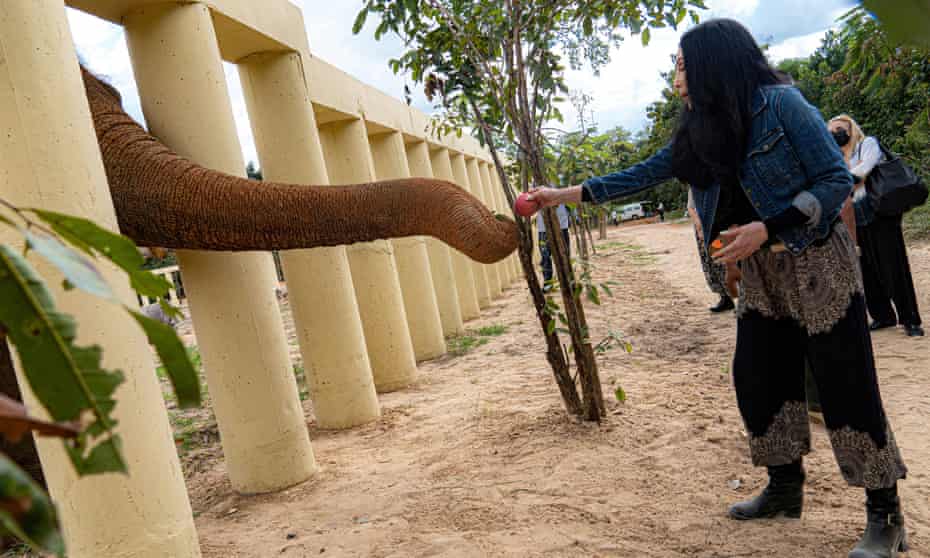
Cher has barely started with her animal liberation plans. “We’re working on a gorilla right now, and another elephant.” Did she grow up with animals? Yes, I’ve had many dogs, and I have cats now.” She lives in Malibu, Los Angeles. “I live in a particularly beautiful spot, but the fires are just killing us. A fire came right up my house and burned the side of it. I was so lucky.” And suddenly we’re back with Trump; she can’t help herself. “It’s climate change. And he wouldn’t give us any money for it. He hates us. He hates California. He doesn’t have one drop of goodness in him.”
Much of Cher’s recent life has been about campaigning – whether politically, to support abused animals or helping disadvantaged people through the pandemic. Her charity Cher Cares, which she runs with Dr Irwin Redlener, the founding director of the National Center for Disaster Preparedness at Columbia University, is directing resources to disadvantaged communities to help them through the Covid crisis.
I hate Trump … He doesn’t have one drop of goodness in him
If it wasn’t for the pandemic she would be playing in Las Vegas, as she has done since 2008. Is it true she gets paid $60m a year for Vegas? “Wait. Say this again, please.” I’m expecting her to tell me not to be so ridiculous, but she is simply considering the figure. “It sounds like a good number, but I don’t know the figure. I know I go to work and I like it and I’m getting paid well, but also I have an overhead you can’t believe. I have 100 people on staff.” Cher is worth an estimated $360m (£270m).
She really has had an incredible life. Cher was born in 1946, her mother the southern beauty Georgia Holt, a bohemian actor/singer-songwriter who got married six times, to five different men. Holt largely brought her up Cher and her half-sister Georganne as a single mother. Cher did not meet her father, an American-Armenian truck driver called John Sarkisian, until she was 11. “He was charming like you cannot believe,” she says. “But he had some larceny in him. He had a criminal past.” Her mother was loving and hot-tempered. Sometimes she hit her (“My mom was from the south and it was kinda the thing”), but usually she championed her. Cher struggled with dyslexia. “My mom was my biggest fan. She said it doesn’t matter, school is not important. And I said: ‘Yeah Mom, but I can’t even see numbers – they look like little scratchy things to me.’ She said: ‘When you grow up, you’re going to have somebody else to do numbers for you.’”
At 16, Cher met 27-year-old Sonny Bono. He was a decent songwriter and a mediocre singer; she was gorgeous with a remarkable contralto. He became her svengali and lover. After working together with Phil Spector (she backed the Ronettes on Be My Baby and the Righteous Brother on You’ve Lost That Lovin’ Feeling), they joined forces and became huge, with hits including the classic I Got You Babe and their own TV show. They were the most famous couple on the planet as a singing duo, a comedy act, and husband and wife. Then it all went to pot.
She was the talent; he took the money – 95% of it, with 5% going to lawyers. Cher divorced him in 1975. “We worked side by side for 11 years and I ended up with nothing. I worked really hard for that money, and it never occurred to me that he would take it.” Actually, she says, she ended up with less than nothing. “I had to give him $2m on top.” Why? “Because I didn’t carry out the contract for Sonny and Cher as a couple. It never occurred to me that I would be charged with the contracts we didn’t fulfil.”
Were you furious with him? “You know, we had such a strange relationship. The day we got our divorce, he grabbed me, bent me backwards and kissed me, and we were hysterical. I couldn’t keep angry with him for some reason. I had a lot of anger, but I couldn’t stay angry.”
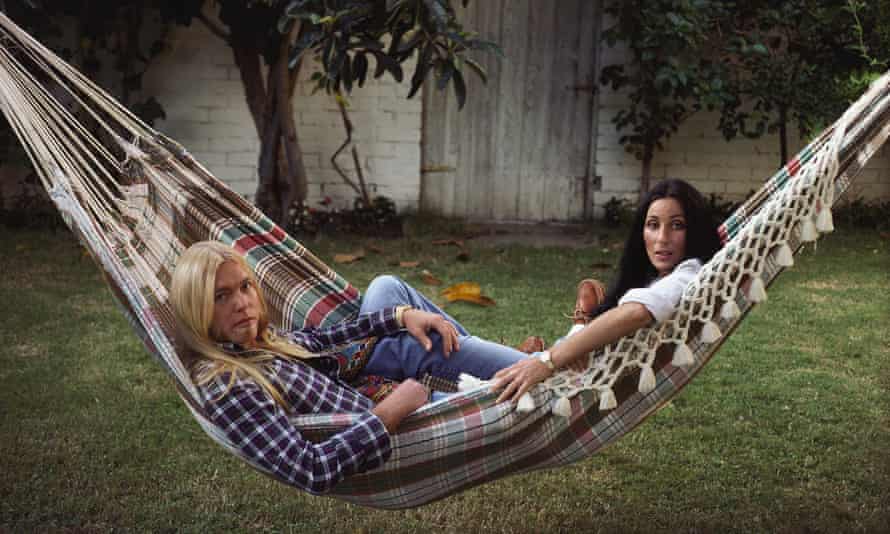
Four days after divorcing Bono, she married the rock star Gregg Allman. Nine days later, she filed for divorce because of his drug and alcohol problems (he was addicted to heroin), although they soon got back together. There have been so many famous men in her life: David Geffen, Tom Cruise, Gene Simmons, Val Kilmer, Warren Beatty, Tommy Lee. And if they weren’t famous at the time, they soon became so. Rob Camilletti, who she dated in the 80s, became known as Bagel Boy because, at the time, she was 40 and he was 22 and he worked in a bagel shop, although he subsequently became a pilot to the stars.
Who has been the love of her life? “Well, I think Robert [Camilletti] and Gregory Allman,” she answers, without a blink. “Gregory was a special man.” And a difficult man? “Well, look, he was a southern gentleman who happened to do drugs. It was that simple. And he tried hard to get off them. One time we were going to a rehab and I said: ‘I’m so tired of doing this,’ and he said: ‘So am I. And I keep doing it for you.’ Robert was completely different. He was like a rock.”
It’s interesting that you call him Gregory, I say. To the public he has always been Gregg. She smiles. “He never called me Cher.” What did he call you? “Chooch.” Why? “People I’m close to don’t call me Cher. They have nicknames. No one ever called me Cher in my whole life.” What does your mother call you? “Honey.”

She once said that Cruise was one of her top-five lovers. Who heads the list? “I’m not telling you that!” Oh Cher, it’s winter, it’s cold, we’re in a pandemic – give us a bit of festive cheer. She laughs. “Tough shit. Don’t even go there. I’ve been around – this ain’t my first time at the rodeo!”
Cher has a touch of Mae West about her – particularly when she talks about men. She once said men are not a necessity; they are luxuries, like dessert (adding that she does love dessert). I start to remind her of the time her mother told her to find herself a rich man, but she beats me to it. “I was struggling to get a movie made. She said: ‘Honey, what you need in your life is a rich man.’ And I went: ‘Mom, I am a rich man.’ It still has a meaning to me. I don’t need that; I am that.”
Few people have reinvented themselves as often or as successfully as Cher. So many decades in music can be encapsulated by her hits – the rousing picaresque pop of Gypsys, Tramps & Thieves and Dark Lady in the 70s; the epic pop-rock of Dead Ringer for Love (with Meat Loaf) and If I Could Turn Back Time in the 80s; the electro-dance pop of Believe in the 90s.
In the 80s she also established herself as a serious, understated actor in Robert Altman’s Come Back to the Five and Dime, Jimmy Dean, Jimmy Dean. There followed memorable performances in films such as Moonstruck, Silkwood and The Witches of Eastwick. In 2018’s Mamma Mia! Here We Go Again, she stole the show with a gloriously camp cameo. It’s hard to think of anybody who has been as successful in movies and music. Yet Cher has never quite received the acclaim she deserves – bizarrely, she has not been inaugurated into the Rock and Roll Hall of Fame.
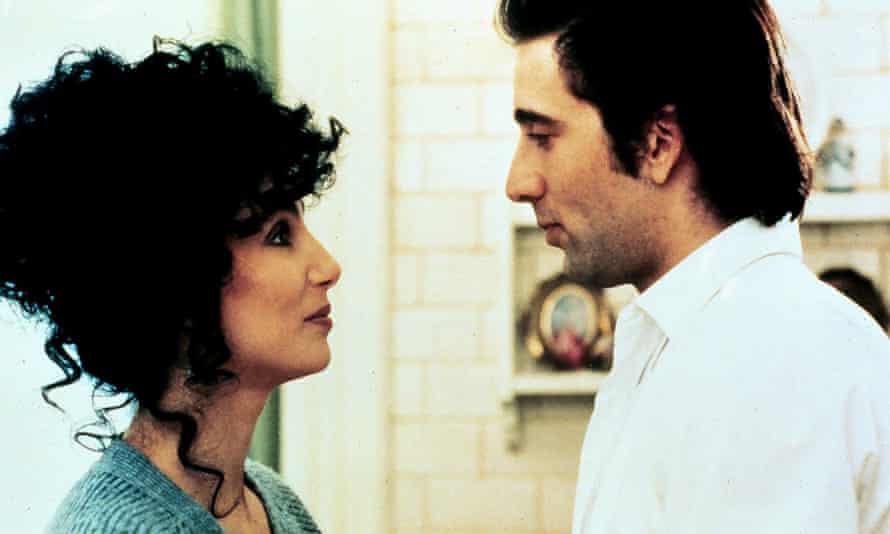
And, of course, few women have been so empowering for other women – the independence, the longevity, the chutzpah and, perhaps most of all, the level-headedness. She has often been surrounded by addicts, but she has remained steadfastly sober. Every element of her life has been played out in public – divorces, affairs, the addiction problems of Allman and their son Elijah, the transitioning of her son Chaz Bono, the fallouts and fall-ins with her mother, cosmetic surgery.
When Chaz transitioned, Cher admitted she found it hard to deal with, and was forever getting her pronouns wrong when talking about him in public. She laughs when I mention it today. “I’m much better at it now.” The mere mention of Chaz reminds her of Trump and what she sees as the erosion of respect and rights in the US. “We’ve gone backwards 20 years. We were making great progress and now all these conservative people don’t want black people voting, they don’t want Latino people voting. They don’t want trans people here. They want to go back to the 50s; antebellum days, if they could.”
There is a surprising stillness to Cher. Even when she rages against Trump she does so quietly. There is also a refreshing openness – many megastars are evasive, talk in soundbites or reel off anecdotes on autopilot. Cher answers fully, as if considering every question for the first time. She doesn’t pretend to be your friend or feign intimacy, but she chats with an honesty verging on the compulsive – as if she knows no other way.
I ask about ageing, and she starts talking about her mother, who is 94, though she claims to be 74 (perversely, Cher’s age). “I’ve always thought of her as this kick-ass chick, and now I start to see my grandmother in her. She’s still lively and we still laugh. But I see her getting older, and it makes me nervous.” For your mother or yourself? “For both of us.”
Does ageing worry her? “I hate it.” She gives me a look. “What, I’m going to say I like it? No, I don’t. Any woman who is honest will say it’s not as much fun. When I was working on the road we used to work two shows a night and then go out dancing all night long.” And now? “It’s like we’ve got to rest because you’ve got another night. Also, I don’t like going out now because everybody’s got a camera and it’s not safe. People rush you, and you don’t know if they’re going to kill you or take your picture. Either way, I don’t like it.”
I love standing on the stage and singing. You just feel like you can fill everything, and I pretty much can
Has anybody been hostile? “I had a man try to kill me. I always got dropped off at the stage door when I was doing Come Back To the Five and Dime on Broadway. I thought he was going to shake my hand, and he grabbed my arm and put it behind my back. He started pushing me down the alleyway, and he said: ‘If you make a sound, I’ll kill you.’ Two fans, who later became friends, saw something was wrong, and they started screaming and ran towards me, and he ran away.”
In the past she has talked about the pressure to remain young in her business. Today, she is renowned as the poster girl for cosmetic surgery. I ask if she thinks she normalised procedures. “Wait, what? You say I made it OK for what?” For normal people, regular civilians, to have cosmetic surgery, I say. “These girls are having surgery at 18. So come on! I’ve never seen girls do so much to want to change everything they look like. I never wanted to do that. You’ve got big lips to start with and a big butt. I don’t understand it.”
Does she think cosmetic surgery has prolonged her career? If you’re no good at what you do, she says, people don’t care what you look like. “You don’t pay bucks to stand and look at someone. They’ve got to deliver something.” She may get tired, she says, but her voice is better than it’s ever been. “And I’ve worked my whole life to keep my strength in my body. There are 20-year-old girls who can’t do what I do.”
Indeed she does look fabulously, freakishly fit. It’s weird how the National Enquirer constantly suggests she is on death’s doorstep. “My entire life I am dying!” She looks as if she’s smiling behind the mask. But I’m not sure. “My entire life.” How does that make her feel? “It’s the Enquirer. It sells magazines. I don’t know why they pick dying because I never have done.”
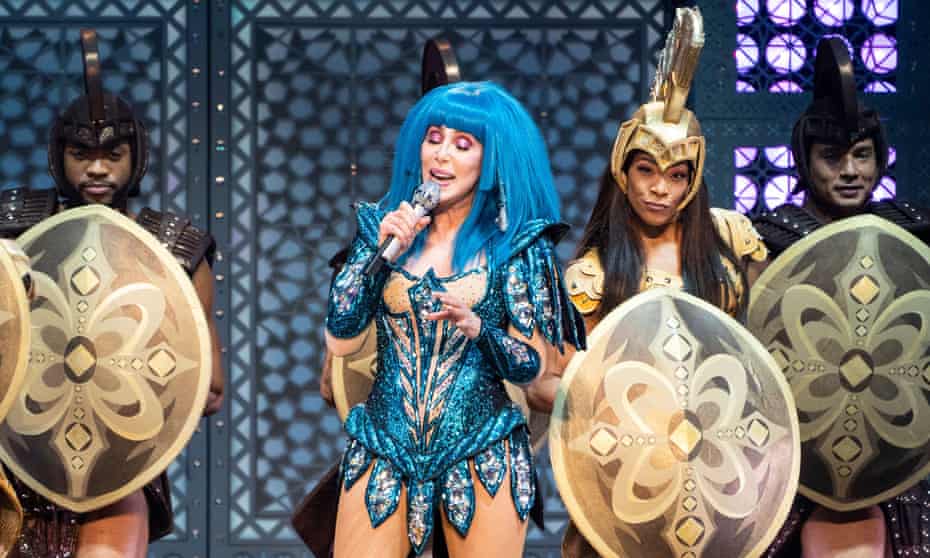
Cher’s first farewell tour started in 2002 and ended three years later, making her an estimated $100m. What keeps her going now? “I love standing on the stage and singing. The feeling you have in your body when you sing.” What is that feeling? “It’s big, no matter how small you are. You just feel like you can fill everything, and I pretty much can. Then you put the audience in. And I’m very shy. But once you get over your stage fright everything gets good.”
But I assumed you would be wildly extrovert – like the Cher on stage. “Nope,” she says. How do you go from one to the other? “A lot of the biggest entertainers are shy. I’ve always been shy. But once I’m on stage and get hold of an audience, I know I can bring the room together as one. No matter how many thousands of people, I can bring it to where they are all friends. If you have a heartbreak or a sickness, for 90 minutes I can make you forget.”
It’s time to leave. Cher gives me a closeup of the elephant knuckle-duster – actually a beautiful ring made for her by another friend, the designer Loree Rodkin. She reminds me how much there is still to do – battling bigotry, rescuing the next Kaavan, helping to ease the pandemic and, hopefully, even that return to Vegas.
I ask what has given her most pleasure in life. What we’ve just been talking about, she says. “Making people happy. It sounds corny, but I mean it. I love being able to take an audience and move them to a different place.” Is she surprised she is still taking them to this different place? “Absolutely,” she says. And now there is no mistaking the smile behind the mask. “Abso-fucking-lutely.”












